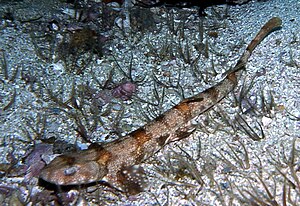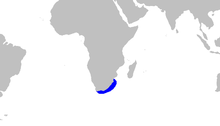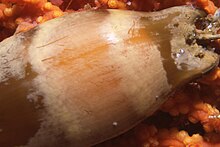Puff adder dogfish
| Puff adder dogfish | ||||||||||||
|---|---|---|---|---|---|---|---|---|---|---|---|---|

Puff adder dogfish ( Haploblepharus edwardsii ) |
||||||||||||
| Systematics | ||||||||||||
|
||||||||||||
| Scientific name | ||||||||||||
| Haploblepharus edwardsii | ||||||||||||
| ( Schinz , 1822) |
The puffadder shyshark ( Haploblepharus edwardsii ) (Afrikaans: Pofadderskaamooghaai , English: puffadder shyshark or colloquially "Happy Eddie" ) is a kind from the family of dogfish (Scyliorhinidae), which is endemic in the waters off the coast of South Africa alive. This regularly occurring shark lives mainly on or near the sea floor in sandy or stony habitats from the intertidal zone to a depth of about 130 meters. He reaches an average body length of about 60 centimeters and has a slim, flattened body and head. Characteristic and eponymous is its eye-catching drawing on the back, which is composed of a series of dark-edged orange-colored saddle spots and numerous white spots. The closely related Natal dogfish ( Haploblepharus kistnasamyi ) was originally a synonym for the puff adder dogfish , but has been a separate species since 2006.
When threatened, the puff adder dogfish - like other species of the genus - curls up in a ring and covers its eyes with its tail, which is why it was locally named "shyshark" (shy shark) or "donut" ( donut ). It lives predatory and feeds mainly on crustaceans , sea worms and small bony fish . It is egg-laying ( oviparous ), and the females lay the eggs individually or in pairs on various underwater structures. Due to its size, the shark, which is harmless to humans, is generally not used by fishermen and disposed of as bycatch . On the Red List of Endangered Species of the International Union for Conservation of Nature (IUCN), the species is listed on the Near Threatened list due to its comparatively small distribution area, as local intensification of commercial fishing or the destruction of the habitat represent possible threats.
features
The puff adder dogfish reaches an average body length of about 60 centimeters and a maximum length of 69 centimeters. The sharks that live west of Cape Agulhas are smaller than the more easterly individuals and only grow to be about 48 centimeters long. The back color is light to dark brown with a series of eight to ten yellow to red-brown and dark-edged saddle spots as well as numerous small white spots. The ventral side is white.
It is slimmer than the other species of the genus and has a short, broad and dorsally flattened head with a slightly rounded snout. The large, oval, rounded eyes have cat-like slit pupils , a simple nictitating membrane and a prominent elevation below the eye. The nostrils are very large and in front each have a pair of greatly enlarged, triangular skin flaps that have grown together and extend to the mouth. A deep pit connects the outflow opening of the nostrils with the mouth, covered by the nasal lobes. The mouth opening is short and has furrows in the corners of the mouth. In the upper jaw there are 26 to 30 rows of teeth, in the lower jaw 27 to 33. The tooth shape differs between the sexes and accordingly represents a sexual dimorphism : the teeth of the males are long and three-pointed, while those of the females are short and five-pointed. What is unusual in comparison to other sharks is an elastic cartilaginous connection between the two halves of the lower jaw, through which the tooth distribution is more even and the biting force is increased.
The five gill slits are shifted to the top of the body. The dorsal, ventral and anal fins are roughly the same size. The dorsal fins start very far back on the body, with the first dorsal fin beginning behind the attachment of the ventral fin and the second dorsal fin behind the anal fin. The pectoral fins are broad and medium-sized. The short and broad caudal fin is about one-fifth the length of the body and has a deep notch near the tip of the upper lobe and a barely developed lower lobe. The skin is thick and covered by heavily calcified, leaf-shaped placoid scales.
distribution and habitat
The range of the puff adder cat shark is limited to the continental shelf of the coast of South Africa from the Langebaan Lagoon in the Western Cape Province to the western edge of Algoa Bay . Earlier finds, some of which extend as far as Durban in the north, are now classified as being confused with other species.
The bottom-living shark occurs mainly in regions with sandy or stony subsoil. The depth of its habitat increases towards the northeastern limit of distribution. This is around 0 to 15 meters in the area of Cape Town and 40 to 130 meters in the area of KwaZulu-Natal . This distribution probably reflects the shark's preference for colder water layers.
Way of life
The puff adder dogfish, which occurs regularly in its range, can very often be observed lying still on the sea floor. He is sociable, and several sharks can rest together in the same place.
nutrition
Like its relatives, the puff adder dogfish is a generalist hunter with teeth designed to capture prey. It feeds according to a number of benthic and close to the ground of living organisms, especially crustaceans and marine worms, and of cephalopods and bony fish such as anchovy , gobies , the two smaller Trevally species Trachurus capensis and Trachurus Delagoa and the crocodile toothfish Champsodon capensis . The males primarily prefer bristle worms , while the females primarily prey on crustaceans. In addition, the shark was seen hunting a common octopus ( Octopus vulgaris ) as it tore off an arm by twisting its body.
Predators and parasites
The puff adder cat shark's predators are larger fish and sharks in its range, for example the broad-nosed seven-gill shark ( Notorynchus cepedianus ). The South African fur seal ( Arctocephalus pusillus ) has been regularly seen catching the small shark and playing with it by throwing it in the air or chewing on it. The seal does take up small pieces of meat, but rarely eats the whole shark. The sharks are often stolen from the seals by Dominican gulls ( Larus dominicanus ) during this behavior . When threatened or disturbed, the puff adder dogfish assumes a characteristic position in which it curls up and covers its eyes with its tail. It is believed that this way the shark is more difficult to swallow for a potential attacker.
The shark's eggs are eaten by sea snails of the Buccinidae family , especially Burnupena papyracea and B. lagenaria .
Among the known parasites of the puff adder-dogfish include, for example of the trypanosomes belonging protozoa Trypanosoma haploblephari that can be detected in the blood of the sharks, the nematode Proleptus obtusus who lives in Haidarm, and as ectoparasites the copepods Charopinus dalmanni and Perissopus oblongatus that stick to the skin. Another parasite is the larva of the sea louse Gnathia pantherina , which infects the shark's nostrils, mouth and gills. With her mouthparts she injures the local tissue so badly that it bleeds or inflammation is caused.
Reproduction and development
The puff adder dogfish is egg-laying ( oviparous ). Reproduction takes place throughout the year and there is no definable breeding season . The females lay their egg capsules individually or in pairs by attaching them to vertical structures in their habitat, such as sea fans . The thin-walled eggs are colored brown and marked with clear light transverse bands, the surface is slightly furry, and the four corners are equipped with long fastening threads. Compared to the eggs of other species of the genus, they are slightly smaller with a length of 3.5 to 5 millimeters and a width of 1.5 to 3 millimeters.
The developing embryos have outer gill filaments up to about 50 days of age and use up their entire yolk sac within the first 100 days or so . Shortly afterwards, the fully trained and active young sharks hatch with a body length of about 10 centimeters.
The sexual maturity reached both sexes at an estimated age of seven, the body length lies between 35 and 55 centimeters. The sharks that live in the deeper waters of the eastern part of the range are likely to become sexually mature somewhat later than the sharks in the western range.
Evolution and systematics
The first known mention of the puff adder cat shark in scientific literature comes from the English naturalist George Edwards . In 1760 he described three sharks that were caught in the area of the Cape of Good Hope in 1758 as "Catulus major vulgaris"; however, the captured specimens have not been preserved. In 1817 the French zoologist Georges Cuvier described the species as "Scyllium D'Edwards", based on Edwards' description. The German zoologist Friedrich Siegmund Voigt translated Cuvier's description in 1832 under the name Scyllium edwardsii , which enabled him to establish a scientific name. In 2001, MJP van Oijen discovered that the Swiss naturalist Heinrich Rudolf Schinz had already made an earlier translation of Cuvier's text in 1822, which also contained the scientific name, whereupon the International Commission on Zoological Nomenclature (ICZN) made the decision that the first description of the species Schinz is attributed. As early as 1913, the American zoologist Samuel Garman described the genus Haploblepharus for this and other dogfish species.
Originally, a distinction was made between two forms of the puff adder cat shark with differing appearance and different habitat preferences, which were known as the Cape and Natal forms. In 2006 the natal form was re-described as a separate species under the name natal catshark ( Haploblepharus kistnasamyi ) and thus raised to the status of a species. A molecular biological investigation based on three genes of the mitochondrial DNA revealed that the puff adder dogfish is the most original species of its genus. The Dark dogfish ( H. pictus ) and the brown cat shark ( H. fuscus ) also represent this investigation sister species represent the natal shyshark was not considered.
| Haploblepharus |
|
||||||||||||
|
|
The common name of this species is derived from the puff adder ( Bitis arietans ) that is widespread in Africa and refers to the similar coloring and drawing of both species. The name "Happy Eddie", which is derived from the scientific name Haploblepharus edwardsii , is mainly used in scientific circles and was generally introduced as an easy-to-remember alternative to the names "shyshark" and "donut", which are used for several species and are accordingly ambiguous.
Relationship with people
The puff adder dogfish is harmless to humans and can be caught by hand.
Because of its small size, the shark for commercial fishing is not of interest, but primarily by bottom trawl fishermen between Mossel Bay and East London and fishermen in the area of False Bay as bycatch caught and discarded. In addition, many of the sharks are caught by anglers from the shore and also killed and disposed of. The sharks are used locally as bait for catching lobsters and kept as aquarium fish . The International Union for Conservation of Nature (IUCN) classifies the puff adder dogfish as a species on the warning list (Near Threatened), because although the species is numerous within its range, it is very small and is in a heavily fished area and therefore an increase in fisheries or a decrease in habitats could have a potentially large effect on the overall population .
supporting documents
- ↑ a b c d e Compagno, LJV, M. Dando and S. Fowler: Sharks of the World . Princeton University Press, 2005, ISBN 978-0-691-12072-0 , pp. 234-235.
- ↑ a b c d e f g Human, BA: A taxonomic revision of the catshark genus Haploblepharus Garman 1913 (Chondrichthyes: Carcharhiniformes: Scyliorhinidae) . In: Zootaxa . 1451, 2007, pp. 1-40. ( PDF )
- ↑ a b c d Compagno, LJV: Sharks of the World: An Annotated and Illustrated Catalog of Shark Species Known to Date . Food and Agricultural Organization, Rome 1984, ISBN 92-5101384-5 , pp. 332-333.
- ↑ a b Bester, C. Biological Profiles: Puffadder Shyshark . Florida Museum of Natural History Ichthyology Department. Retrieved August 31, 2009.
- ↑ a b c Van der Elst, R .: A Guide to the Common Sea Fishes of Southern Africa , third. Edition, Struik, 1993, ISBN 1-86825-394-5 , p. 71.
- ^ A b Andrea Ferrari, Anna Bennett, Antonella Ferrari: Sharks . Firefly Books, 2002, ISBN 1-55209-629-7 , pp. 131 .
- ^ Heemstra, E. and P. Heemstra: Coastal Fishes of Southern Africa . NISC and SAIAB, 2004, ISBN 1-920033-01-7 , p. 67.
- ↑ a b c Dainty, AM (2002). Biology and ecology of four catshark species in the southwestern Cape, South Africa. M.Sc. thesis, University of Cape Town.
- ↑ Lechanteur, YARG and CL Griffiths: Diets of common suprabenthic reef fish in False Bay, South Africa . In: African Zoology . 38, No. 2, October 2003, pp. 213-227.
- ↑ Ebert, DA: Diet of the seven gill shark Notorynchus cepedianus in the temperate coastal waters of southern Africa . In: South African Journal of Marine Science . 11, No. 1, December 1991, pp. 565-572.
- ↑ Martin, RA: Natural mortality of puffadder shysharks due to Cape fur seals and black-backed kelp gulls at Seal Island, South Africa . In: Journal of Fish Biology . 64, No. 3, 2004, pp. 711-716. doi : 10.1111 / j.1095-8649.2004.00339.x .
- ↑ a b Smith, C. and C. Griffiths: Shark and skate egg-cases cast up on two South African beaches and their rates of hatching success, or causes of death . In: South African Journal of Zoology . 32, No. 4, October 1997, pp. 112-117.
- ^ Yeld, EM and NJ Smit: A new species of Trypanosoma (Kinetoplastida: Trypanosomatidae) infecting catsharks from South Africa . In: Journal of the Marine Biological Association of the United Kingdom . 86, No. 4, 2006, pp. 829-833. doi : 10.1017 / S0025315406013750 .
- ↑ Moravec, F., JG Van As and I. Dykova: Proleptus obtusus Dujardin, 1845 (Nematoda: Physalopteridae) from the puffadder shyshark Haploblepharus edwardsii (Scyliorhinidae) from off South Africa . In: Systematic Parasitology . 53, No. 3, November 2002, pp. 169-173. doi : 10.1023 / A: 1021130825469 . PMID 12510161 .
- ↑ Dippenaar, SM: Reported siphonostomatoid copepods parasitic on marine fishes of southern Africa . In: Crustaceana . 77, No. 11, 2004, pp. 1281-1328. doi : 10.1163 / 1568540043165985 .
- ↑ Hayes, PM, NJ Smit and AJ Davies: Pathology associated with parasitic juvenile gnathiids feeding on the puffadder shyshark, Haploblepharus edwardsii (Voight) . In: Journal of Fish Diseases . 30, No. 1, 2007, pp. 55-58. doi : 10.1111 / j.1365-2761.2007.00777.x . PMID 17241405 .
- ↑ Von Bonde, C .: The external development of the banded dogfish or pofadderhaai Haploblepharus edwardsii (M. & H.) . In: The Biological Bulletin . 88, No. 1, 1945, pp. 1-10. doi : 10.2307 / 1538166 .
- ↑ George Edwards: Gleanings of natural history, Exhibiting figures of quadrupeds, birds, insects, etc . 1760. pp. 169-170, fig. 289
- ↑ Human, BA and Compagno, LJV: Description of Haploblepharus kistnasamyi , a new catshark (Chondrichthyes: Scyliorhinidae) from South Africa . In: Zootaxa . 1318, 2006, pp. 41-58. ( PDF )
- ↑ Human, BA, EP Owen, LJV Compagno and EH Harley: Testing morphologically based phylogenetic theories within the cartilaginous fishes with molecular data, with special reference to the catshark family (Chondrichthyes; Scyliorhinidae) and the interrelationships within them . In: Molecular Phylogenetics and Evolution . 39, No. 2, May 2006, pp. 384-391. doi : 10.1016 / j.ympev.2005.09.009 . PMID 16293425 .
- ↑ a b S.L. Fowler, RD Cavanagh, M. Camhi, GH Burgess, GM Cailliet, SV Fordham, CA Simpfendorfer, JA Musick: Sharks, Rays and Chimaeras: The Status of the Chondrichthyan Fishes . International Union for Conservation of Nature and Natural Resources, 2005, ISBN 2-8317-0700-5 , pp. 265 .
Web links
- Haploblepharus edwardsii in the Red List of Threatened Species of the IUCN 2013.1. Posted by: Human, B., 2008. Retrieved November 6, 2013.



